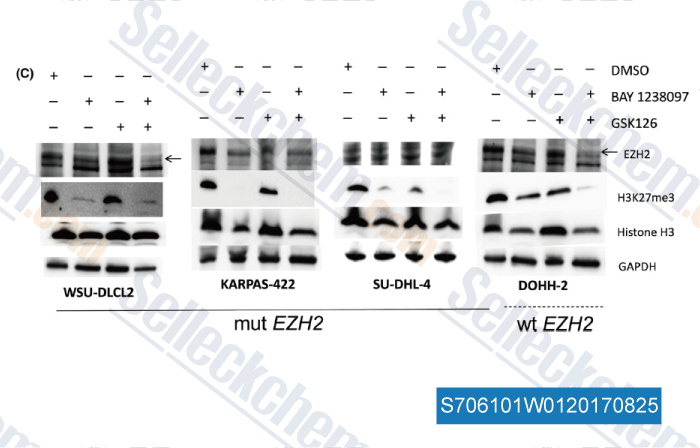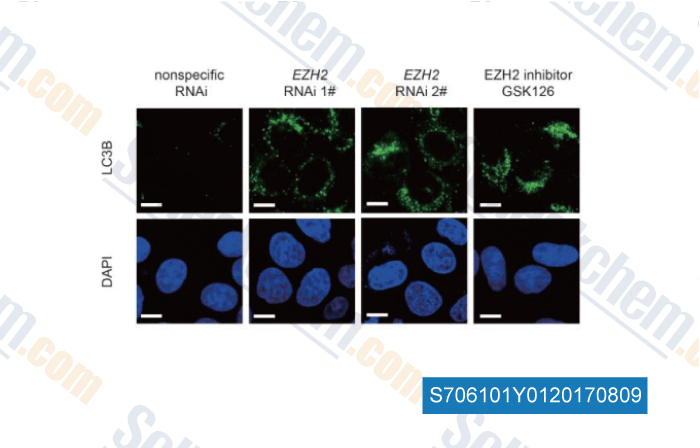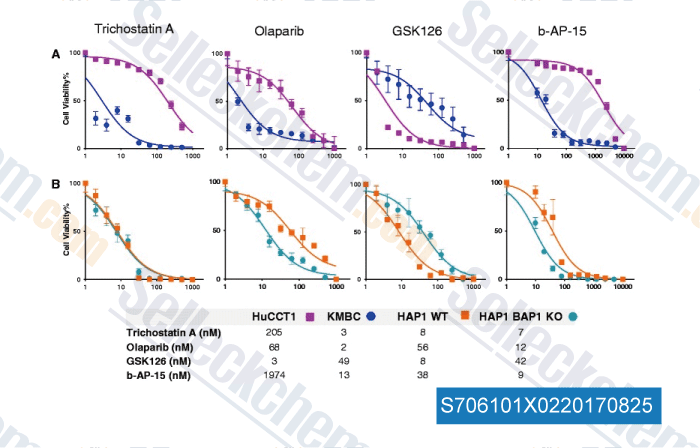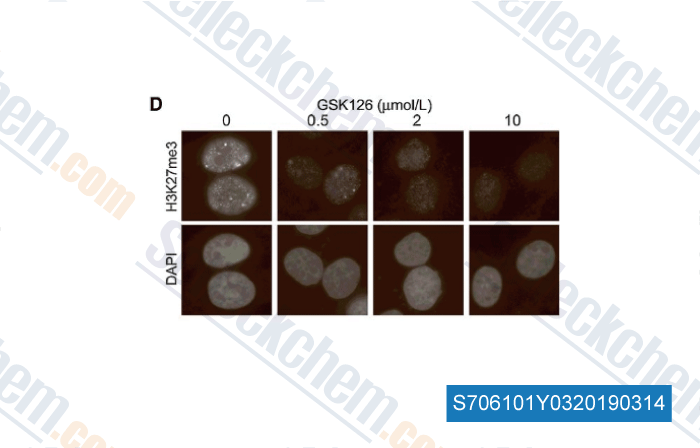|
Toll Free: (877) 796-6397 -- USA and Canada only -- |
Fax: +1-832-582-8590 Orders: +1-832-582-8158 |
Tech Support: +1-832-582-8158 Ext:3 Please provide your Order Number in the email. |
Technical Data
| Formula | C31H38N6O2 |
||||||
| Molecular Weight | 526.67 | CAS No. | 1346574-57-9 | ||||
| Solubility (25°C)* | In vitro | DMSO | 16 mg/mL (30.37 mM) | ||||
| Ethanol | 6 mg/mL (11.39 mM) | ||||||
| Water | Insoluble | ||||||
| In vivo (Add solvents to the product individually and in order) |
|
||||||
|
* <1 mg/ml means slightly soluble or insoluble. * Please note that Selleck tests the solubility of all compounds in-house, and the actual solubility may differ slightly from published values. This is normal and is due to slight batch-to-batch variations. * Room temperature shipping (Stability testing shows this product can be shipped without any cooling measures.) |
|||||||
Preparing Stock Solutions
Biological Activity
| Description | GSK126 (GSK2816126A, GSK2816126) is a potent, highly selective EZH2 methyltransferase inhibitor with IC50 of 9.9 nM, >1000-fold selective for EZH2 over 20 other human methyltransferases. | ||
|---|---|---|---|
| Targets |
|
||
| In vitro | In vitro, GSK126 most potently inhibits H3K27me3, followed by H3K27me2 in both EZH2 wild-type and mutant DLBCL cell lines. GSK126 also effectively inhibits the proliferation of EZH2 mutant DLBCL cell lines, and induces transcriptional activation of EZH2 target genes in sensitive cell lines. [1] In A687V EZH2-mutant cells, GSK126 treatment results in a global decrease in H3K27me3, robust gene activation, caspase activation, and decreased proliferation. [2] In parental H2087 cells, GSK126 inhibits the expression of VEGF-A and phosphorylated Ser(473)-AKT, and thus causes the inhibition of cell proliferation, migration and metastasis. [3] | ||
| In vivo | In mice bearing KARPAS-422 and Pfeiffer xenografts, GSK126 (150 mg/kg/d, i.p.) decreases global H3K27me3, increases gene expression, and thus causes marked tumour regression. [1] |
Protocol (from reference)
| Kinase Assay: |
|
|---|---|
| Cell Assay: |
|
| Animal Study: |
|
References
|
Customer Product Validation

-
, , Br J Haematol, 2017, 178(6):936-948

-
Data from [ , , Autophagy, 2015, 11(12):2309-22. ]

-
Data from [ , , Mol Cancer, 2017, 16(1):22 ]

-
Data from [ , , Mol Cancer Res, 2018, 16(3):417-427 ]
Selleck's GSK126 has been cited by 185 publications
| EZH2 inhibition sensitizes MYC-high medulloblastoma cancers to PARP inhibition by regulating NUPR1-mediated DNA repair [ Oncogene, 2025, 44(6):391-405] | PubMed: 39562655 |
| Inhibiting EZH2 complements steroid effects in Duchenne muscular dystrophy [ Sci Adv, 2025, 11(11):eadr4443] | PubMed: 40085707 |
| Suppressed macrophage response to quorum-sensing-active Streptococcus pyogenes occurs at the level of the nucleus [ bioRxiv, 2025, 2025.02.07.637189] | PubMed: 39975246 |
| Protocol for differentiating cardiomyocytes and generating engineered heart tissues from human feeder-free extended pluripotent stem cells [ STAR Protoc, 2025, 6(1):103576] | PubMed: 39893639 |
| Unveiling the effects of GSK126 on osteosarcoma cells implications for apoptosis, autophagy, and cellular migration [ Discov Oncol, 2025, 16(1):245] | PubMed: 40014170 |
| EZH2 inhibitors promote β-like cell regeneration in young and adult type 1 diabetes donors [ Signal Transduct Target Ther, 2024, 9(1):2] | PubMed: 38161208 |
| Increased translation driven by non-canonical EZH2 creates a synthetic vulnerability in enzalutamide-resistant prostate cancer [ Nat Commun, 2024, 15(1):9755] | PubMed: 39567499 |
| A SWI/SNF-dependent transcriptional regulation mediated by POU2AF2/C11orf53 at enhancer [ Nat Commun, 2024, 15(1):2067] | PubMed: 38453939 |
| Epigenetic dysregulation of eukaryotic initiation factor 3 subunit E (eIF3E) by lysine methyltransferase REIIBP confers a pro-inflammatory phenotype in t(4;14) myeloma [ Haematologica, 2024, 109(6):1893-1908] | PubMed: 38124661 |
| Refractory testicular germ cell tumors are highly sensitive to the targeting of polycomb pathway demethylases KDM6A and KDM6B [ Cell Commun Signal, 2024, 22(1):528] | PubMed: 39482699 |
RETURN POLICY
Selleck Chemical’s Unconditional Return Policy ensures a smooth online shopping experience for our customers. If you are in any way unsatisfied with your purchase, you may return any item(s) within 7 days of receiving it. In the event of product quality issues, either protocol related or product related problems, you may return any item(s) within 365 days from the original purchase date. Please follow the instructions below when returning products.
SHIPPING AND STORAGE
Selleck products are transported at room temperature. If you receive the product at room temperature, please rest assured, the Selleck Quality Inspection Department has conducted experiments to verify that the normal temperature placement of one month will not affect the biological activity of powder products. After collecting, please store the product according to the requirements described in the datasheet. Most Selleck products are stable under the recommended conditions.
NOT FOR HUMAN, VETERINARY DIAGNOSTIC OR THERAPEUTIC USE.
